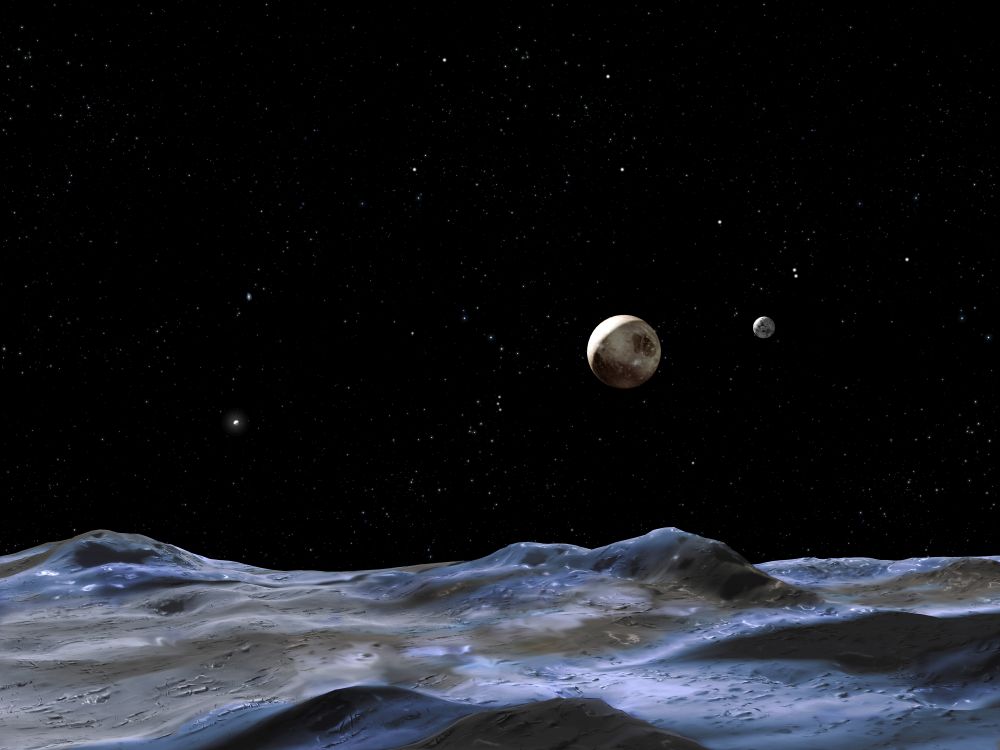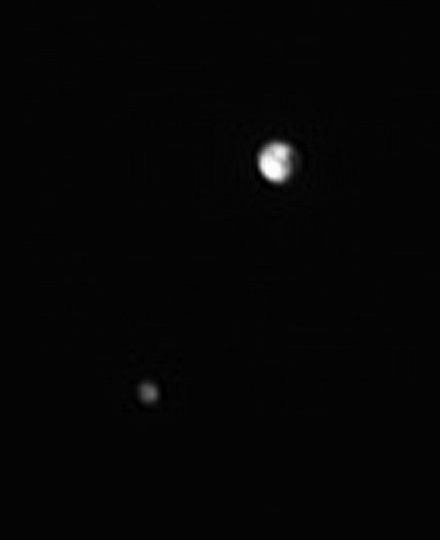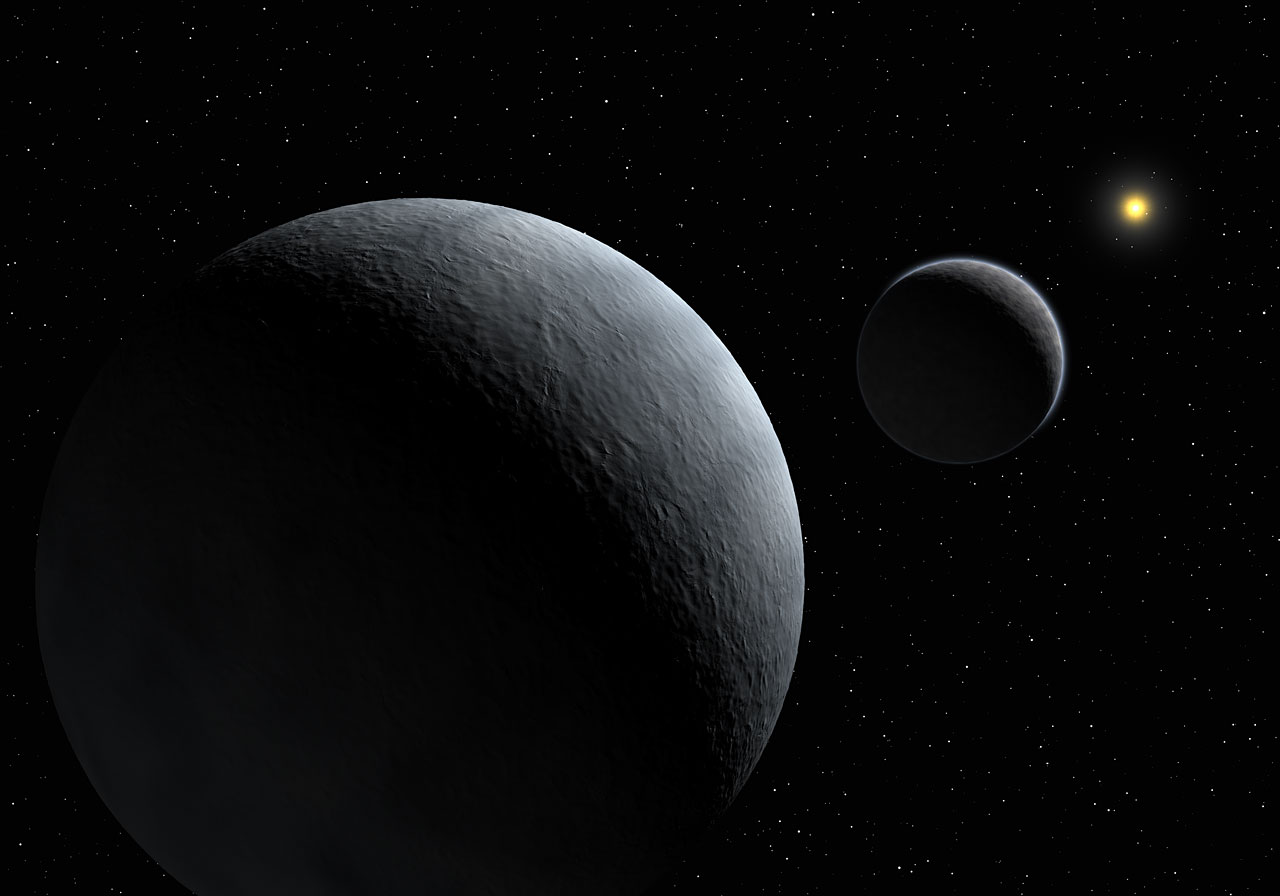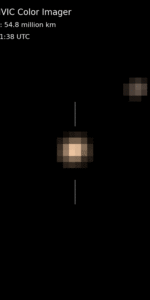
With less than four weeks remaining before NASA’s New Horizons spacecraft speeds through the Pluto system for humanity’s first-ever close-up reconnaissance of the distant planet and its assortage of moons, speculation runs rampant among scientists and the general public alike about what these mysterious worlds at the outer reaches of the Solar System might look like up close. In the absence of any hard evidence thus far, scientists can only make educated guesses about what we’ll actually see when New Horizons makes its long-awaited flyby of Pluto and its moons on July 14.
In one such study, a team of U.S. astronomers has argued about the possibility for the existence of cracks on the surface of Pluto’s biggest moon Charon, not unlike those that have been documented on the surface of Jupiter’s moon Europa. If such findings were indeed to be uncovered on Charon, they would provide strong evidence for the existence of past liquid water oceans on the interior of the faraway frigid moon.

One of the great revelations of planetary exploration has been that our Solar System is awash in water, from the dry plains of Mars to the interiors of various outer icy moons like Jupiter’s Europa and Ganymede and Saturn’s moon Enceladus. In addition, the presence of water has been confirmed even in the most unlikely of places, like the permanently shadowed crates at the south poles of Mercury and the Earth’s Moon, as well as on dwarf planets like Ceres, providing a paradigm shift in our views about the prevalence of this all-important molecule in our planetary backyard. But what about more distant places in the Solar System, like Pluto and Charon? Could we find any evidence for the existence of subterranean layers of liquid water, like those that are believed to exist on Europa and Enceladus?
The vast network of crisscrossing cracks that are seen on the surface of Europa are caused by the intense tidal forces of the massive, nearby Jupiter and the orbital resonances with the other nearby moons of the Jovian system, similar to the way that the gravity of the Earth’s Moon causes tides on the oceans of our home planet. As Europa moves in its orbit it is constantly pulled and stretched by nearby Jupiter. This constant flexing of Europa by Jupiter’s immense gravity melts its interior in the same way it melts that of neighboring moon Io, in essence keeping the water ice layers in the interior of Europa in a liquid state that form a global underground ocean. Furthermore, since Europa lies inside Jupiter vast magnetosphere, the latters’ magnetic field lines are passing right through the moon itself, creating an induced magnetic field near its surface, with the underground liquid water ocean acting as a conductive material. Yet, none of these conditions are currently present on the Pluto-Charon system. Both of these celestial bodies lack any significant magnetic field. Furthermore, they are locked in a mutual synchronous rotation while having an almost circular, no-eccentric orbit, which disfavor the formation of any currently active geological processes on their surfaces or interiors.
Even though Pluto and Charon might today most probably be geologically inactive, that may not have been the case in the past. A team of U.S. astronomers, led by Dr. Alyssa Rhoden, a planetary scientist at NASA’s Goddard Space Flight Center, in Greenbelt, Md., studied several formation and evolutionary models of the Pluto-Charon system, in order to check what specific geologic features each one would produce on the surface of Charon that could be possibly observed by the New Horizons spacecraft. The leading theory for Charon’s formation is that it formed similar to the way that the Earth and Moon have formed: from the accumulated orbital debris that surrounded Pluto after a giant impactor hit the latter during the early history of the Solar System. According to this theory, both Pluto and Charon were initially much closer toward one another and subsequently started to move away, until they were locked to their present synchronous rotation. What Rhoden’s team observed in their study was that during this process, several models predict that Charon’s orbit around Pluto could have been highly eccentric, which would have caused severe tides on both celestial bodies, possibly leading to the formation of underground oceans of liquid water, similar to those that probably exist inside Europa.
In order to test their hypothesis, the researchers would need more data regarding the eccentricity of Charon’s orbit, as well as the interior structure of Pluto and Charon and in particular the thickness, strength, and viscosity of the latter’s underground ice shell, which are currently unavailable. In the absence of this data, Rhoden’s team calculated various values about the latter, in order to see how much eccentric would Charon’s orbit would have to be for tidal forces to have any significant effect. Their results showed that tidal forces on Charon could play a significant role, even with a miniscule orbital eccentricity. “Depending on exactly how Charon’s orbit evolved, particularly if it went through a high-eccentricity phase, there may have been enough heat from tidal deformation to maintain liquid water beneath the surface of Charon for some time,” says Rhoden. “Using plausible interior structure models that include an ocean, we found it wouldn’t have taken much eccentricity (less than 0.01) to generate surface fractures like we are seeing on Europa.”

In this scenario, these tidal forces would produce noticeable geologic features on Charon’s surface, which could be observed, if there, by New Horizons during its close flyby of the Pluto system next month. “The New Horizons spacecraft should provide the first images of the surfaces of Pluto and Charon,” write the researchers in their study, which was published on the journal Icarus. “Our predictions indicate that the presence (or absence) of tidally driven fractures could be used to constrain Charon’s internal structure and orbital parameters at the time of fracture formation. Furthermore, these fractures should be distinct from those produced through orbital recession and de-spinning. If tidally driven fractures are quite prevalent, it would require that Charon experienced a high eccentricity during its orbital evolution and that the ice shell remained relatively warm during this time period. In contrast, very limited tidal fracturing would place upper limits on Charon’s eccentricity and the viscosity of the ice shell. The specific distribution of fractures, either sparse or numerous, could be used to further distinguish between a thick and thin ice shell.”
“Our model predicts different fracture patterns on the surface of Charon depending on the thickness of its surface ice, the structure of the moon’s interior and how easily it deforms, and how its orbit evolved,” adds Rhoden. “By comparing the actual New Horizons observations of Charon to the various predictions, we can see what fits best and discover if Charon could have had a subsurface ocean in its past, driven by high eccentricity.”
As is always the case in scientific research, new theories and hypotheses must pass the test of hard facts and observations, in order to be validated or discarded. Whatever the case regarding the presence of ancient, frozen water oceans on Charon may be, New Horizons’ observations will provide significant new insights about the prevalence of water in the Solar System and beyond. “NASA science activities have provided a wave of amazing findings related to water in recent years that inspire us to continue investigating our origins and the fascinating possibilities for other worlds, and life, in the universe,” comments Dr. Ellen Stofan, Chief Scientist for NASA at the agency’s headquarters, in Washington, D.C. “In our lifetime, we may very well finally answer whether we are alone in the Solar System and beyond.”
If the history of planetary exploration is any indication, then New Horizons is bound to provide the next paradigm shift in our understanding of the many different and fascinating worlds within our planetary family and possibly beyond as well.
Stay with AmericaSpace for regular updates and LIVE COVERAGE of New Horizons’ approach and flyby of the Pluto system.
Be sure to “Like” AmericaSpace on Facebook and follow us on Twitter: @AmericaSpace
Missions » New Horizons »






“the prevalence of water in our solar system”……most likely to be confirmed with continued exploration in our “neighborhood.” It also suggests that the “prevalence” of water is a common occurrence throughout the Universe.
Indeed, you’re quite right Tom, these studies showcase the fascinating concept that the we’re most probably living in a ‘wet’ Universe, with water being abundant throughout. I’m patiently waiting for the first observations of future telescopes like the James Webb, that will be able to peer into the atmospheres of exoplanets and see what’s there.